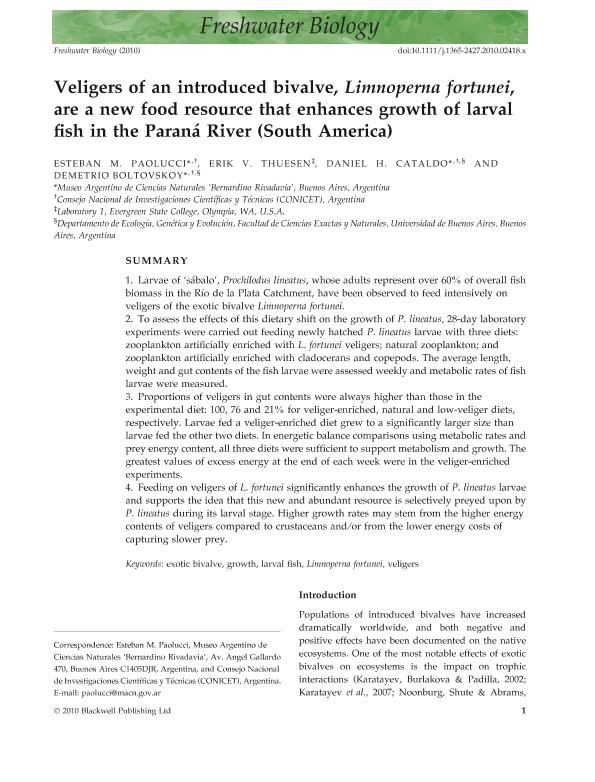Mostrar el registro sencillo del ítem
dc.contributor.author
Paolucci, Esteban Marcelo

dc.contributor.author
Thuesen, Erik V

dc.contributor.author
Cataldo, Daniel Hugo

dc.contributor.author
Boltovskoy, Demetrio

dc.date.available
2019-01-28T20:19:37Z
dc.date.issued
2010-09
dc.identifier.citation
Paolucci, Esteban Marcelo; Thuesen, Erik V; Cataldo, Daniel Hugo; Boltovskoy, Demetrio; Veligers of an introduced bivalve, Limnoperna fortunei, are a new food resource that enhances growth of larval fish in the Paraná River (South America); Wiley Blackwell Publishing, Inc; Freshwater Biology (print); 55; 9; 9-2010; 1831-1844
dc.identifier.issn
0046-5070
dc.identifier.uri
http://hdl.handle.net/11336/68819
dc.description.abstract
1. Larvae of 'sábalo', Prochilodus lineatus, whose adults represent over 60% of overall fish biomass in the Río de la Plata Catchment, have been observed to feed intensively on veligers of the exotic bivalve Limnoperna fortunei.2. To assess the effects of this dietary shift on the growth of P. lineatus, 28-day laboratory experiments were carried out feeding newly hatched P. lineatus larvae with three diets: zooplankton artificially enriched with L. fortunei veligers; natural zooplankton; and zooplankton artificially enriched with cladocerans and copepods. The average length, weight and gut contents of the fish larvae were assessed weekly and metabolic rates of fish larvae were measured.3. Proportions of veligers in gut contents were always higher than those in the experimental diet: 100, 76 and 21% for veliger-enriched, natural and low-veliger diets, respectively. Larvae fed a veliger-enriched diet grew to a significantly larger size than larvae fed the other two diets. In energetic balance comparisons using metabolic rates and prey energy content, all three diets were sufficient to support metabolism and growth. The greatest values of excess energy at the end of each week were in the veliger-enriched experiments.4. Feeding on veligers of L. fortunei significantly enhances the growth of P. lineatus larvae and supports the idea that this new and abundant resource is selectively preyed upon by P. lineatus during its larval stage. Higher growth rates may stem from the higher energy contents of veligers compared to crustaceans and/or from the lower energy costs of capturing slower prey.
dc.format
application/pdf
dc.language.iso
eng
dc.publisher
Wiley Blackwell Publishing, Inc

dc.rights
info:eu-repo/semantics/openAccess
dc.rights.uri
https://creativecommons.org/licenses/by-nc-sa/2.5/ar/
dc.subject
Exotic Bivalve
dc.subject
Growth
dc.subject
Larval Fish
dc.subject
Limnoperna Fortunei
dc.subject
Veligers
dc.subject.classification
Otras Ciencias Biológicas

dc.subject.classification
Ciencias Biológicas

dc.subject.classification
CIENCIAS NATURALES Y EXACTAS

dc.title
Veligers of an introduced bivalve, Limnoperna fortunei, are a new food resource that enhances growth of larval fish in the Paraná River (South America)
dc.type
info:eu-repo/semantics/article
dc.type
info:ar-repo/semantics/artículo
dc.type
info:eu-repo/semantics/publishedVersion
dc.date.updated
2019-01-25T13:39:05Z
dc.journal.volume
55
dc.journal.number
9
dc.journal.pagination
1831-1844
dc.journal.pais
Reino Unido

dc.journal.ciudad
Londres
dc.description.fil
Fil: Paolucci, Esteban Marcelo. Consejo Nacional de Investigaciones Científicas y Técnicas. Oficina de Coordinación Administrativa Parque Centenario. Museo Argentino de Ciencias Naturales “Bernardino Rivadavia”; Argentina
dc.description.fil
Fil: Thuesen, Erik V. Evergreen State College; Estados Unidos
dc.description.fil
Fil: Cataldo, Daniel Hugo. Consejo Nacional de Investigaciones Científicas y Técnicas. Oficina de Coordinación Administrativa Ciudad Universitaria. Instituto de Ecología, Genética y Evolución de Buenos Aires. Universidad de Buenos Aires. Facultad de Ciencias Exactas y Naturales. Instituto de Ecología, Genética y Evolución de Buenos Aires; Argentina
dc.description.fil
Fil: Boltovskoy, Demetrio. Consejo Nacional de Investigaciones Científicas y Técnicas. Oficina de Coordinación Administrativa Parque Centenario. Museo Argentino de Ciencias Naturales “Bernardino Rivadavia”; Argentina. Consejo Nacional de Investigaciones Científicas y Técnicas. Oficina de Coordinación Administrativa Ciudad Universitaria. Instituto de Ecología, Genética y Evolución de Buenos Aires. Universidad de Buenos Aires. Facultad de Ciencias Exactas y Naturales. Instituto de Ecología, Genética y Evolución de Buenos Aires; Argentina
dc.journal.title
Freshwater Biology (print)

dc.relation.alternativeid
info:eu-repo/semantics/altIdentifier/doi/http://dx.doi.org/10.1111/j.1365-2427.2010.02418.x
dc.relation.alternativeid
info:eu-repo/semantics/altIdentifier/url/https://onlinelibrary.wiley.com/doi/abs/10.1111/j.1365-2427.2010.02418.x
Archivos asociados
